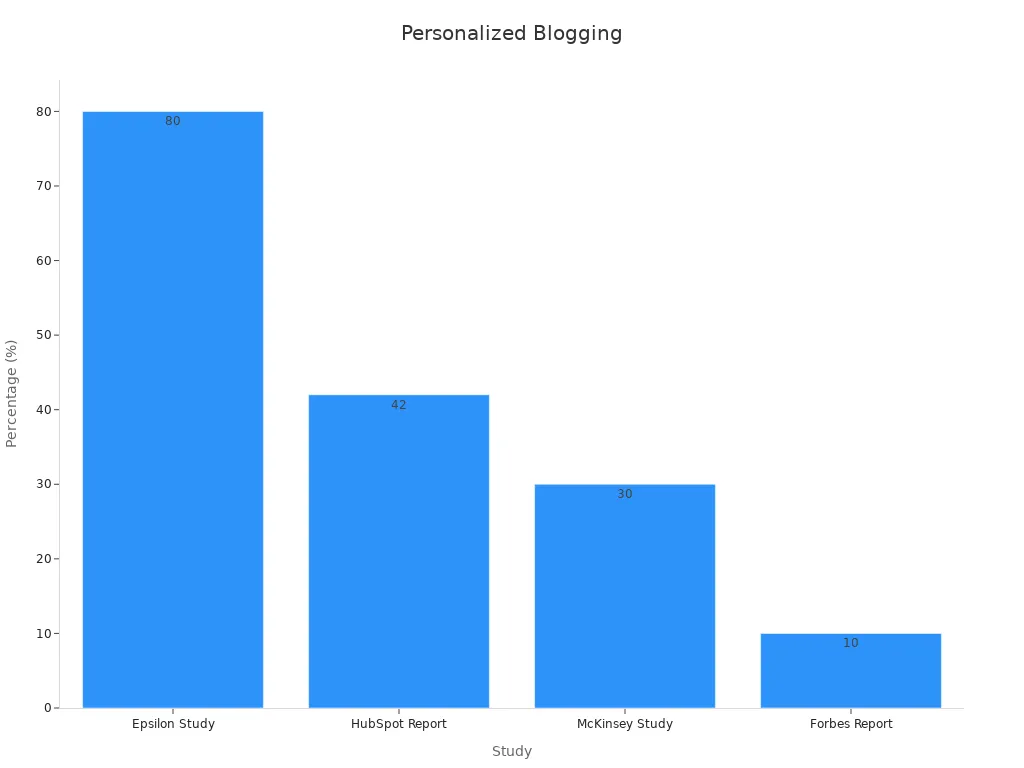Personalizing Blog Content with AI for Better Impact

Have you ever felt a blog was made just for you? That’s the power of personalizing blog content. It’s not only about putting a name in an email; it’s about creating content that feels meaningful. For example:
75% say personal messages make them loyal to a brand.
66% would stop buying if content didn’t fit their needs.
AI enhances this process significantly. It studies behavior to predict what you’ll enjoy. Bloggers can save time, write better posts, and connect with readers more effectively. This is a major shift for building stronger relationships through personalizing blog content.
Key Takeaways
Making blog content personal helps readers feel valued and loyal. Most people like brands that send messages just for them.
AI helps bloggers write custom posts by studying what readers like. This builds stronger connections and gets more people interested.
Predicting trends with AI lets bloggers guess what readers want. This keeps blog topics new and exciting.
Testing AI-made posts is very important. Trying different versions and asking for feedback makes sure the posts fit readers and the brand.
Mixing AI tools with human ideas improves blog writing. Use AI for research and drafts, but add your own style to connect better.
Understanding AI-Powered Personalizing Blog Content
What is AI content personalization?
AI content personalization means making content feel special for you. It uses smart technology to study data and guess what you’ll like. Think about Netflix or Amazon. They suggest shows or items based on what you’ve watched or bought. That’s AI doing its job!
Here’s how it works:
AI collects data like your searches, location, and purchases.
It uses this data to suggest products, ads, or even prices.
You might notice chatbots or content that matches your interests. These are examples of AI personalization.
This tech makes online browsing easier and more fun. It’s like having a helper who knows what you want.
The evolution from generic to personalized content
Personalization didn’t always use AI. It started with simple things, like adding names to emails. Over time, businesses saw that custom experiences mattered. Social media and email tools began helping brands connect better.
Big companies like Netflix and Amazon took it further. They moved from plain content to unique experiences. For example, Netflix creates a homepage just for you. This change shows how important personalization is today.
Now, people expect personalization. If businesses don’t adapt, they might lose customers to others who do it better.
Why personalization is essential for modern blogging
Personalization isn’t just popular—it’s a big deal for blogs. Research says 80% of people prefer brands that personalize. Custom calls-to-action (CTAs) can increase clicks by 42%. Companies using personalization often earn 10% more money.
When you personalize blogs, you’re not just writing—you’re connecting. This builds trust, keeps readers loyal, and turns them into customers. In today’s busy online world, personalization helps your blog shine.

Using AI to personalize blogs makes your writing more meaningful. It’s not just about words—it’s about making a difference.
How AI Personalization Works

The role of data in personalizing blog content
Data is key to AI personalization. It helps AI learn what you like. Every time you click, search, or share online, you leave clues. AI collects these clues to make content just for you.
For example:
Many businesses struggle to use data without proper tools.
AI-driven personalization makes content match your interests better.
Companies use data to create offers that build loyalty and trust.
AI doesn’t just see what you’ve done. It guesses what you’ll want next. This makes blogs feel more personal. It’s like a friend who knows what you enjoy and suggests it.
Tools and technologies for AI-driven personalization
AI personalization uses many tools to work well. These tools help in different areas, like shopping or learning. Here’s a simple comparison:
Tool/Technology | Where It’s Used | How It Helps Personalization |
|---|---|---|
Shopping platforms | Product suggestions | Boosts sales by showing items based on your likes. |
Streaming apps | Show recommendations | Keeps users happy with custom content choices. |
Health services | Custom treatments | Gives health advice based on patient details. |
Learning websites | Adaptive lessons | Makes studying easier with tailored materials. |
Other tech like computer vision, NLP, and generative AI also help. For instance:
Computer Vision helps stores personalize shopping with face recognition.
NLP makes chatbots understand you better for smoother chats.
Generative AI creates custom posts quickly, helping bloggers connect with readers.
These tools make personalizing blogs faster and smarter.
Techniques like NLP and machine learning in action
AI doesn’t just gather data—it uses smart methods like NLP and machine learning to understand it. These methods help AI adjust content to fit your needs. Here are some examples:
Example Type | How It Works |
|---|---|
Sentiment Analysis | NLP checks comments to see how readers feel, helping bloggers adjust their tone. |
Chatbots | Chatbots give custom answers and tips based on your questions. |
Automated Summarization | NLP creates short blog summaries, making reading faster and easier. |
Customer Support Automation | NLP sorts questions to improve response times and make help more personal. |
Personalized Recommendations | Chatbots suggest blogs or products you might like based on your activity. |
Machine learning makes AI even smarter. It learns from what you do and gets better over time. For example, if you read travel blogs, AI might suggest budget trips or hidden spots. This keeps content fresh and interesting.
By using NLP and machine learning, AI makes blogs feel like they’re written just for you.
Steps to Implement AI in Personalizing Blog Content
Collecting and analyzing customer data
To make your blog personal, start by gathering data. Think of data as the base for your strategy. Every click, search, or purchase tells you something important. Your job is to understand these clues and use them to create content people enjoy.
There are easy ways to collect and study data. For example, use website tools to track actions or surveys to ask questions. Once you have the data, AI helps you understand it better. It finds patterns and trends that might be hard to see on your own.
Here’s a simple table showing methods and examples for studying data:
Statistical Model/Case Study | What It Does |
|---|---|
Regression Analysis | Predicts what customers might do based on past actions. |
Clustering Algorithms | Groups customers by similar behaviors. |
Time Series Analysis | Looks at past patterns to guess future trends. |
Netflix Case Study | Uses AI to suggest shows based on what users like. |
Moneyball Case Study | Finds hidden value in players to improve team results. |
These methods help you learn what your audience wants. This makes personalizing blogs easier and more effective.
Using predictive analytics for audience insights
After collecting data, the next step is guessing what readers will want. Predictive analytics works like a smart tool for your blog. It uses AI to study past actions and predict future interests. This keeps your blog ahead of your audience’s needs.
Here’s how predictive analytics helps your blog:
Optimizing resource allocation: It helps you plan topics that readers will enjoy most.
Create go-to-market strategies: It shows trends so you can adjust your content and marketing.
Improving decision-making: It helps you make smart choices to keep readers engaged.
For example, if readers love travel tips, predictive analytics might suggest writing about cheap trips or packing hacks. This keeps your blog helpful and interesting.
Creating dynamic, adaptive content
Old-style blogs don’t change, but modern blogs adapt to readers. Dynamic content adjusts to fit each person’s likes, making them feel special.
AI helps create this type of content. It uses tools like personalization engines and collaboration systems to change what readers see. Here are examples of how AI makes content adaptive:
Dynamic Intelligence: Changes based on user actions to give better help.
Personalization Engine: Saves user preferences to show custom content.
Collaboration Engine: Learns from interactions to make responses more natural.
Imagine a blog that changes its look or tone depending on the reader. That’s adaptive content. It keeps people interested and wanting more.
Testing and improving AI-created content
Testing AI-made content is like fixing a recipe. You have the basics, but need to adjust for the best result. AI can make content fast, but testing ensures it fits your audience. Let’s explore how to test and improve AI-made content for better results.
Why testing is important
Imagine posting a blog without knowing if it works. That’s like guessing in the dark. Testing shows what works and what doesn’t. It helps your content connect with readers and meet goals. It also ensures AI-made content matches your brand’s style and values.
Ways to test AI-made content
There are many ways to test your content. Here are some useful ones:
A/B Testing: Compare two versions—one by AI, one by a person. Check which gets more clicks, shares, or sales.
User Behavior Tracking: Use tools like heatmaps to see how people interact. Are they clicking, scrolling, or leaving quickly?
Snippet Checks: See how often your content appears in Google snippets.
Engagement Stats: Look at bounce rates, time spent on the page, and clicks.
Sales Metrics: Track how your content affects sales and customer value.
Tip: Start small. Test one or two things at a time to stay focused.
Making your content better
After testing, it’s time to improve your content. Think of this as polishing a rough gem. Here’s how to do it:
Match Your Brand: Make sure the tone and style fit your brand. If it feels wrong, adjust the language.
Stay Relevant: Check how long your posts stay useful. Update old posts to keep them fresh.
Boost Retention: Watch for repeat visits or subscriptions. If these are low, add more personal touches.
Voice Search Ready: Many people use voice devices. Add conversational phrases to match voice searches.
Feedback matters
Feedback is your secret tool. Ask readers what they think about your content. Use surveys, comments, or polls to learn more. AI can help analyze feedback, but your judgment is key. You know your audience best.
Note: Testing and improving isn’t a one-time job. It’s something you do often to stay ahead.
By testing and improving, your AI-made content becomes great, not just good. This helps you connect with readers and make your blog more personal and effective.
Benefits of AI in Personalizing Blog Content

Better audience connection and happiness
When blogs feel personal, readers feel special. AI helps by matching content to what people like. For example, colleges saw more interest by customizing their websites for visitors. Sharing useful info, like tailored calls-to-action (CTAs), boosts clicks and builds trust.
Here’s how personalization improves satisfaction:
Strategy | Result |
|---|---|
Custom website designs | Makes visiting more fun and enjoyable. |
Tailored CTAs | Increases clicks and keeps customers loyal. |
Feedback-based changes | Adjusts content to fit what readers want. |
By listening to readers and using AI, you can make blogs they’ll love to revisit.
Higher conversions and better results
AI personalization doesn’t just make blogs fun—it gets results. Super-customized content can boost conversions by 60%. Imagine if every post felt perfect for your readers. AI also helps get new customers, raising conversion rates by 30%.
When you personalize blogs, you’re not just writing—you’re building loyal fans. This means better results for your time and effort.
Faster and smarter content creation
Making personal content might seem slow, but AI speeds it up. It handles boring tasks, cuts research time, and avoids mistakes. This lets you focus on being creative while AI does the hard work.
Here’s how AI makes things easier:
Evidence Type | Description |
|---|---|
Task Automation | Finishes boring jobs quickly, saving time. |
Faster Research | Finds info fast so you can write quicker. |
Fewer Errors | Creates reliable content with fewer mistakes. |
With AI, you can write more in less time without losing quality. This helps you stay ahead in the busy blogging world.
Tips for Refining AI-Generated Content
Mixing AI speed with human creativity
AI works fast but isn’t perfect. That’s where you help. Combining AI’s quick tasks with your ideas makes blogs better. AI can draft or study data, while you add personality and meaning.
Here’s how some companies use AI with human input:
Sage Publishing saved time by using AI to write book summaries.
Cosabella improved ads by 50% and cut costs by 12% with AI.
Adobe used AI chat tools to earn $10.8 million more revenue.
PepsiCo made eco-friendly reports faster with AI help.
When AI and your creativity work together, blogs feel personal. It’s not just about machines—it’s about making your blog unique.
Protecting your brand’s voice and style
Your brand’s voice shows who you are. AI can help keep it, but you must guide it. Share your tone, style, and key ideas with AI tools. This helps the content match your brand’s feel.
Be honest with readers. Tell them AI helps make your content. This builds trust and shows you care about being real. Always check AI-made content before posting. Fix it to match your values and add a personal touch.
Here’s how to keep your voice strong:
Use AI for tasks but keep the tone friendly.
Compare AI outputs with your brand’s past work often.
By mixing AI with your edits, your blog stays true to your brand and connects with readers.
Updating AI tools and methods
AI changes fast, so staying updated is important. New tools and ideas can make your blog better and keep readers interested.
Here’s a simple table of AI types and uses:
AI Type | What It Does |
|---|---|
Traditional AI | Suggests products and improves website searches. |
Conversational AI | Answers questions using smart chat tools, great for customer help. |
Generative AI | Creates new content quickly, helping with campaigns and posts. |
To stay ahead, try new tools and change your plans as needed. Regular updates keep your blog fresh and exciting. AI is powerful, but it needs your input to work its best.
Using AI to personalize blog content isn’t just popular—it’s powerful. It changes how you connect with readers, making each moment special. One expert said:
“Personalized content isn’t optional anymore. It sets you apart. It turns ordinary experiences into memorable ones.”
AI tools make personalization quicker and simpler. They help you suggest things people like, keep them interested, and boost results. For example:
More interest with custom suggestions.
Better results from tailored ideas.
Stronger loyalty by showing readers they matter.
The benefits last a long time. AI personalization keeps you ahead in a tough market. Experts say the global AI market will grow five times bigger in five years. Now is the best time to try these tools. Whether you write blogs or run a business, AI can improve your content and build strong bonds with your audience.
FAQ
What is the best AI tool for personalizing blog content?
There isn’t one perfect tool for everyone. Your needs decide the best fit. Tools like ChatGPT, HubSpot, or Grammarly help with writing. For tracking data, try Google Analytics or Adobe Sensei. Test different tools to find what works for you.
Tip: Use free trials first to check features before buying.
Can AI replace human creativity in blogging?
No, it can’t! AI helps with tasks like research and drafts. But your ideas make blogs special for readers. Think of AI as a helper, not a replacement. It handles details while you focus on stories and connecting with people.
How does AI know what my readers want?
AI looks at clicks, searches, and time spent on pages. It studies patterns to guess what readers like. For example, if travel blogs are popular, AI might suggest writing about packing tips or secret spots. It’s like having a smart helper for audience insights!
Is AI personalization expensive?
Not always. Many tools have free or cheap plans for beginners. As your blog grows, you can pay for better features. Start small and spend more when you see good results.
Note: Free tools like Google Analytics are great for starting personalization.
Will AI personalization work for all types of blogs?
Yes, it will! Whether your blog is about tech, food, or travel, AI adjusts. It matches content to what your readers enjoy. Even small blogs can use personalized tips, CTAs, and layouts to improve.
Emoji Insight: 🎯 AI helps you connect perfectly with your readers every time!
See Also
Transforming Blogging Through Innovative AI Blog Creation Tools
Comprehensive AI Blog Builders: Writing, Hosting, And SEO Solutions
Customizing Blog Content To Suit Startup Audience Requirements
Blog SEO Mastery 2024: Your Complete Guide To Optimization
Proven Techniques To Grow Your Blogging Audience Effectively

